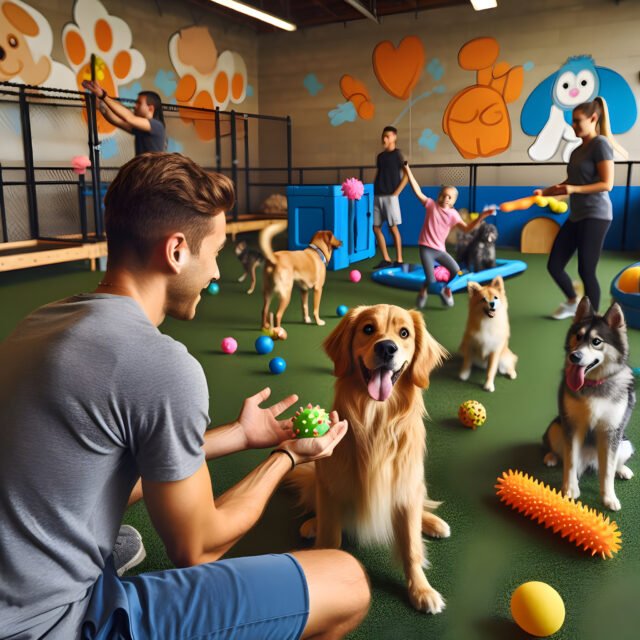Introduction
As pet owners increasingly rely on Pet Day Care facilities to ensure their furry companions are cared for while they’re away, the importance of health and hygiene in such environments cannot be overstated. These centers offer a structured space for pets, mainly dogs and cats, to socialize, exercise, and relax. However, just like human daycares, shared spaces for pets come with health risks that demand proactive management.
From the risk of infectious diseases to behavioral issues and accidents, Pet Day Care centers must adopt strict health protocols to keep pets safe. This blog dives deep into the most common health concerns in pet daycare environments and the effective strategies used to handle them.
Infectious Diseases in Pet Day Care
Respiratory Infections (Kennel Cough and More)
Respiratory infections are among the most frequent ailments in pet daycare environments, particularly in dogs. One of the most well-known is kennel cough, a highly contagious condition caused by a mix of bacteria and viruses, including Bordetella bronchiseptica.
Symptoms include persistent coughing, sneezing, nasal discharge, and lethargy. While often mild, it can become severe, especially in puppies or senior dogs.
Management strategies:
- Mandatory vaccinations (especially for Bordetella)
- Isolation of symptomatic pets
- Improved ventilation and air filtration
- Daily sanitization of toys, bowls, and shared surfaces
Gastrointestinal Issues
Digestive issues, such as vomiting and diarrhea, are common, especially when pets are stressed or exposed to unfamiliar food or bacteria. Contaminated water, unclean feeding areas, and improper waste disposal can lead to outbreaks of illnesses caused by parasites like Giardia or bacteria like E. coli.
Daycares prevent these issues through:
- Strict feeding routines using owner-provided food
- Clean and sanitized water dispensers
- Regular fecal checks and deworming protocols
- Quick response to any signs of digestive discomfort
Skin Infections and Parasites
Skin infections, allergies, and external parasites such as fleas, ticks, and mites can spread quickly in group settings. Some pets may develop rashes, hotspots, or irritation due to allergies triggered by other pets or unfamiliar grooming products.
Mitigation practices include:
- Regular inspection for parasites
- Use of pet-safe cleaning products
- Encouraging flea/tick prevention for all enrolled pets
- Grooming schedules to maintain hygiene
Behavioral Health and Stress Management
Separation Anxiety and Overstimulation
Even the friendliest pets can struggle with being in a new environment without their owners. Separation anxiety manifests in behaviors like pacing, whining, or destructive chewing. Overstimulation due to constant interaction with other pets can also lead to stress and aggression.
Effective management involves:
- Gradual introduction to the daycare environment
- Creating quiet zones for rest and recovery
- Enrichment activities to distract and soothe anxious pets
- Training staff to identify early signs of stress
Aggression and Social Tensions
Not all pets get along instantly. Personality clashes, resource guarding (especially over Dog Toys or food), and lack of social skills can cause fights or injuries. Behavioral health is just as crucial as physical wellness in group settings.
Management tools include:
- Comprehensive temperament testing before enrollment
- Structured playgroups based on size, temperament, and play style
- Immediate intervention during conflicts
- Training programs to improve social behavior
Injury from Rough Play or Accidents
Even in a well-managed daycare, occasional accidents happen—dogs may injure themselves while jumping, running, or engaging in rough play. Slippery floors, sharp edges, or inappropriate Dog Toys can increase risks.
To reduce injury rates:
- Supervisors monitor all interactions closely
- Use of non-slip flooring and pet-friendly play equipment
- Regular maintenance of toys and physical structures
- First-aid readiness and staff trained in emergency response
Environmental and Facility-Related Health Risks
Air and Surface Quality
The overall hygiene and air quality in a daycare can make a major difference in controlling the spread of diseases. Pet dander, fur, and waste, if not managed, can lead to respiratory and skin issues for both pets and staff.
Solutions include:
- High-efficiency air filters
- Humidity control systems to prevent mold and bacterial growth
- Daily cleaning protocols using pet-safe disinfectants
- Strict waste disposal methods
Temperature Regulation and Ventilation
Animals are highly sensitive to temperature. Extreme heat can cause heatstroke in dogs, especially those with thick coats or flat faces. Poor ventilation may worsen the spread of airborne pathogens.
Daycares address this with:
- Climate-controlled indoor environments
- Shade and water access in outdoor play areas
- Emergency procedures for extreme weather conditions
- Monitoring pets’ physical condition during hot days
Noise Levels and Their Impact
Continuous barking and noise from a group of animals can lead to hearing stress and anxiety, especially in smaller or older pets. High noise levels also increase cortisol, the stress hormone, in both animals and humans.
To counteract this:
- Designated quiet zones and nap times
- Acoustic treatments in walls and ceilings
- Limited group sizes per room
- Noise-masking features like calming music
Final Thoughts
While Pet Day Care offers a wealth of benefits, from social interaction to mental stimulation, it’s essential to recognize and manage the health concerns that can arise in such shared environments. Through a combination of proactive measures—ranging from sanitation and vaccination protocols to behavioral support and staff training—modern pet daycares can effectively keep pets safe and healthy.
By being aware of these risks and understanding how they’re managed, pet owners can make informed decisions and select facilities that prioritize health, safety, and well-being. Whether it’s choosing the right Dog Toys or understanding the importance of social group dynamics, responsible pet care goes beyond basic feeding and walking. It’s about creating a community that supports the whole health of every animal.
With the right systems in place, pet daycare can be a wonderful and safe second home for our four-legged companions.







